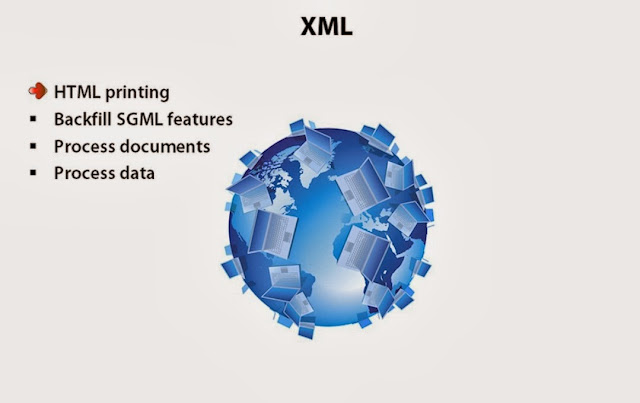XML (Extensible Markup Language) is a flexible way to create common information
formats and share both the format and the data on the
World Wide Web, intranets, and elsewhere. For example, computer makers might agree on a standard or
common way to describe the information about a computer product (processor speed, memory size, and
so forth) and then describe the product information format with XML. Such a standard way of
describing data would enable a user to send an intelligent agent (a program) to each computer
maker's Web site, gather data, and then make a valid comparison. XML can be used by any individual
or group of individuals or companies that wants to share information in a consistent way.
XML, a formal recommendation from the World Wide Web Consortium (W3C), is similar
to the language of today's Web pages, the Hypertext Markup Language (HTML). Both XML
and HTML contain markup symbols
to describe the contents of a page or file. HTML, however, describes the content of a Web page
(mainly text and graphic images) only in terms of how it is to be displayed and interacted with.
For example, the letter "p" placed within markup tags starts a new paragraph. XML describes the
content in terms of what data is being described.
XML is "extensible" because, unlike HTML, the markup symbols are unlimited and self-defining.
XML is actually a simpler and easier-to-use subset of the Standard Generalized Markup Language (SGML), the
standard for how to create a document structure. It is expected that HTML and XML will be used
together in many Web applications. XML markup, for example, may appear within an HTML page.
Extensible Markup Language (XML) is a markup language that defines a set of rules for encoding documents in a format that is both human-readable and machine-readable. It is defined in the XML 1.0 Specification[3] produced by the W3C, and several other related specifications,[4] all free open standards.[5]
The design goals of XML emphasize simplicity, generality, and usability over the Internet.[6] It is a textual data format with strong support via Unicode
for the languages of the world. Although the design of XML focuses on
documents, it is widely used for the representation of arbitrary data structures, for example in web services.
Many application programming interfaces (APIs) have been developed to aid software developers with processing XML data, and several schema systems exist to aid in the definition of XML-based languages.
As of 2009, hundreds of document formats using XML syntax have been developed,[7] including RSS, Atom, SOAP, and XHTML. XML-based formats have become the default for many office-productivity tools, including Microsoft Office (Office Open XML), OpenOffice.org and LibreOffice (OpenDocument), and Apple's iWork. XML has also been employed as the base language for communication protocols, such as XMPP.
XML Fundamentals Course Overview
What is XML
XML Data Model
Interface Definition language is base for most of XML and HTML APIs
Here XSL is sometimes called as XSL:FORMATTING
XML Structure
Parsed Entity
UnParsed Entity
Firefox rendering logic structure of the XML document
Content and Markup
Element Normal Form
Attribute Normal Form
Element Declarations
Attribute Declarations
Parameter Entities
Namespaces in XML
Languages and XML
Whitespace, Comments and Processing Instructions






































































































































































































































No comments:
Post a Comment